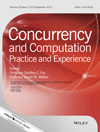A correlation context-aware approach for composite service selection
SUMMARY
Composite service selection is one of the core research issues in Web service composition. Because of the complex service correlation context, candidate services may perform differently when being used with other services. Presently, most service selection approaches ignore this issue, which makes the selected composite services less efficient than expected. To solve this problem, a service correlation context-aware composite service selection approach is proposed on the basis of the concept of single-entry single-exit (SESE) region. The general process of our approach is as follows: (1) mining the SESE patterns that are frequently used together in the set of efficiently executed instances of a composite service; (2) dividing the process model of the composite service into SESE regions and generating the candidate SESE pattern set of each region, using the discovered SESE pattern set; and (3) optimizing composite service selection globally on the basis of QoS using divided regions as selection units and their candidate pattern sets as candidate service sets. Because SESE patterns are testified by large amount of efficiently executed instances, they have higher quality than the results of independent selection of services in an SESE region. Experimental results demonstrated that our approach can improve the quality of selected composite services effectively in the correlation context. Concurrency and Computation: Practice and Experience, 2012.© 2013 Wiley Periodicals, Inc.




